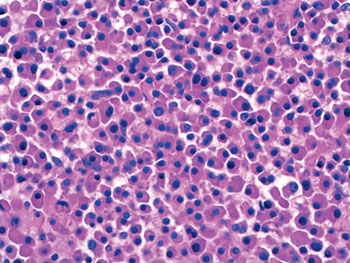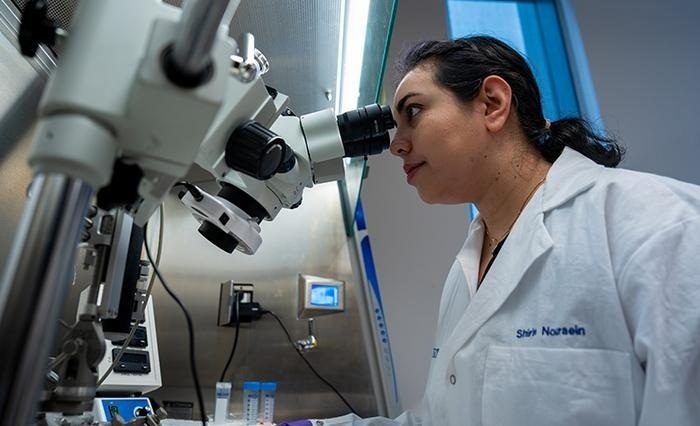Near Real-Time Osteoporosis and Bone Cancer Test Developed
|
By LabMedica International staff writers Posted on 30 Aug 2015 |

Image: Photomicrograph demonstrating typical multiple myeloma histology, with monoclonal proliferation of plasma cells (Photo courtesy of Ohio State University College of Medicine).
A new test which measures changes in calcium isotope ratios offers the possibility of near real time monitoring of bone diseases, such as osteoporosis and multiple myeloma.
Bones are largely built of calcium, and the turnover of calcium can indicate the development of bone diseases such as osteoporosis and the cancer multiple myeloma and using techniques developed by geochemists it was found possible to apply them to a new, rapid test of bone health.
Scientists at Arizona State University (Tempe, AZ, USA) worked with the US National Aeronautics and Space Administration (NASA, Washington DC, USA) and measured calcium isotope ratios in urine from 30 shuttle astronauts, before, during, and after the flights. This allowed them to confirm that the test worked at high sensitivity. They also looked at a group of 71 patients who either had multiple myeloma (bone cancer), or were at risk of multiple myeloma.
The methodology used mass spectrometry and can discern the relative ratios of the calcium isotopes 42Ca and 44Ca in bone. The researchers found that lighter calcium isotopes, such as 42Ca, are absorbed from the blood into the bone during bone formation. Conversely, these light isotopes tend to be released into the bloodstream when bones break down. By measuring the ratios of the two isotopes in blood or urine scientists can calculate the rate of change of bone mass.
Ariel Anbar, PhD, the lead scientists of the study said, “What we saw with cancer patients was interesting. Those patients who tended to lose the lighter 42Ca isotope seemed to be the ones where the cancer was the most active. This means that the tests could theoretically feed into decisions on whether or not to treat a patient, for example if a cancer was dormant or growing very slowly, and to assess the effectiveness of treatments. The advantage for this methodology is that the patient doesn't have to come to the machine; the measurements can be done with a blood or urine test.”
Related Links:
Arizona State University
US National Aeronautics and Space Administration
Bones are largely built of calcium, and the turnover of calcium can indicate the development of bone diseases such as osteoporosis and the cancer multiple myeloma and using techniques developed by geochemists it was found possible to apply them to a new, rapid test of bone health.
Scientists at Arizona State University (Tempe, AZ, USA) worked with the US National Aeronautics and Space Administration (NASA, Washington DC, USA) and measured calcium isotope ratios in urine from 30 shuttle astronauts, before, during, and after the flights. This allowed them to confirm that the test worked at high sensitivity. They also looked at a group of 71 patients who either had multiple myeloma (bone cancer), or were at risk of multiple myeloma.
The methodology used mass spectrometry and can discern the relative ratios of the calcium isotopes 42Ca and 44Ca in bone. The researchers found that lighter calcium isotopes, such as 42Ca, are absorbed from the blood into the bone during bone formation. Conversely, these light isotopes tend to be released into the bloodstream when bones break down. By measuring the ratios of the two isotopes in blood or urine scientists can calculate the rate of change of bone mass.
Ariel Anbar, PhD, the lead scientists of the study said, “What we saw with cancer patients was interesting. Those patients who tended to lose the lighter 42Ca isotope seemed to be the ones where the cancer was the most active. This means that the tests could theoretically feed into decisions on whether or not to treat a patient, for example if a cancer was dormant or growing very slowly, and to assess the effectiveness of treatments. The advantage for this methodology is that the patient doesn't have to come to the machine; the measurements can be done with a blood or urine test.”
Related Links:
Arizona State University
US National Aeronautics and Space Administration
Latest Pathology News
- AI Tool Outperforms Doctors in Spotting Blood Cell Abnormalities
- AI Tool Rapidly Analyzes Complex Cancer Images for Personalized Treatment
- Diagnostic Technology Performs Rapid Biofluid Analysis Using Single Droplet
- Novel Technology Tracks Hidden Cancer Cells Faster
- AI Tool Improves Breast Cancer Detection
- AI Tool Predicts Treatment Success in Rectal Cancer Patients
- Blood Test and Sputum Analysis Predict Acute COPD Exacerbation
- AI Tool to Transform Skin Cancer Detection with Near-Perfect Accuracy
- Unique Immune Signatures Distinguish Rare Autoimmune Condition from Multiple Sclerosis
- Simple Optical Microscopy Method Reveals Hidden Structures in Remarkable Detail
- Hydrogel-Based Technology Isolates Extracellular Vesicles for Early Disease Diagnosis
- AI Tool Improves Accuracy of Skin Cancer Detection
- Highly Sensitive Imaging Technique Detects Myelin Damage
- 3D Genome Mapping Tool to Improve Diagnosis and Treatment of Genetic Diseases
- New Molecular Analysis Tool to Improve Disease Diagnosis
- Tears Offer Noninvasive Alternative for Diagnosing Neurodegenerative Diseases
Channels
Molecular Diagnostics
view channel
New Serum Marker-Editing Strategy to Improve Diagnosis of Neurological Diseases
Tracking gene-expression changes in the brain is crucial for understanding neurological diseases, yet current monitoring tools are invasive or unable to capture subtle activity shifts over time.... Read more
World’s First Genetic Type 1 Diabetes Risk Test Enables Early Detection
Type 1 Diabetes (T1D) affects more than eight million people worldwide, with numbers expected to rise sharply. While most cases are genetically driven, only one in ten patients has a family history, making... Read moreHematology
view channel
Platelet Activity Blood Test in Middle Age Could Identify Early Alzheimer’s Risk
Early detection of Alzheimer’s disease remains one of the biggest unmet needs in neurology, particularly because the biological changes underlying the disorder begin decades before memory symptoms appear.... Read more
Microvesicles Measurement Could Detect Vascular Injury in Sickle Cell Disease Patients
Assessing disease severity in sickle cell disease (SCD) remains challenging, especially when trying to predict hemolysis, vascular injury, and risk of complications such as vaso-occlusive crises.... Read more
ADLM’s New Coagulation Testing Guidance to Improve Care for Patients on Blood Thinners
Direct oral anticoagulants (DOACs) are one of the most common types of blood thinners. Patients take them to prevent a host of complications that could arise from blood clotting, including stroke, deep... Read moreImmunology
view channel
Gene Signature Test Predicts Response to Key Breast Cancer Treatment
DK4/6 inhibitors paired with hormone therapy have become a cornerstone treatment for advanced HR+/HER2– breast cancer, slowing tumor growth by blocking key proteins that drive cell division.... Read more
Chip Captures Cancer Cells from Blood to Help Select Right Breast Cancer Treatment
Ductal carcinoma in situ (DCIS) accounts for about a quarter of all breast cancer cases and generally carries a good prognosis. This non-invasive form of the disease may or may not become life-threatening.... Read moreMicrobiology
view channelRapid POC Tuberculosis Test Provides Results Within 15 Minutes
Tuberculosis remains one of the world’s deadliest infectious diseases, and reducing new cases depends on identifying individuals with latent infection before it progresses. Current diagnostic tools often... Read more
Rapid Assay Identifies Bloodstream Infection Pathogens Directly from Patient Samples
Bloodstream infections in sepsis progress quickly and demand rapid, precise diagnosis. Current blood-culture methods often take one to five days to identify the pathogen, leaving clinicians to treat blindly... Read morePathology
view channelAI Tool Outperforms Doctors in Spotting Blood Cell Abnormalities
Diagnosing blood disorders depends on recognizing subtle abnormalities in cell size, shape, and structure, yet this process is slow, subjective, and requires years of expert training. Even specialists... Read more
AI Tool Rapidly Analyzes Complex Cancer Images for Personalized Treatment
Complex digital biopsy images that typically take an expert pathologist up to 20 minutes to assess can now be analyzed in about one minute using a new artificial intelligence (AI) tool. The technology... Read moreTechnology
view channel
AI Saliva Sensor Enables Early Detection of Head and Neck Cancer
Early detection of head and neck cancer remains difficult because the disease produces few or no symptoms in its earliest stages, and lesions often lie deep within the head or neck, where biopsy or endoscopy... Read more
AI-Powered Biosensor Technology to Enable Breath Test for Lung Cancer Detection
Detecting lung cancer early remains one of the biggest challenges in oncology, largely because current tools are invasive, expensive, or unable to identify the disease in its earliest phases.... Read moreIndustry
view channel
Abbott Acquires Cancer-Screening Company Exact Sciences
Abbott (Abbott Park, IL, USA) has entered into a definitive agreement to acquire Exact Sciences (Madison, WI, USA), enabling it to enter and lead in fast-growing cancer diagnostics segments.... Read more
























